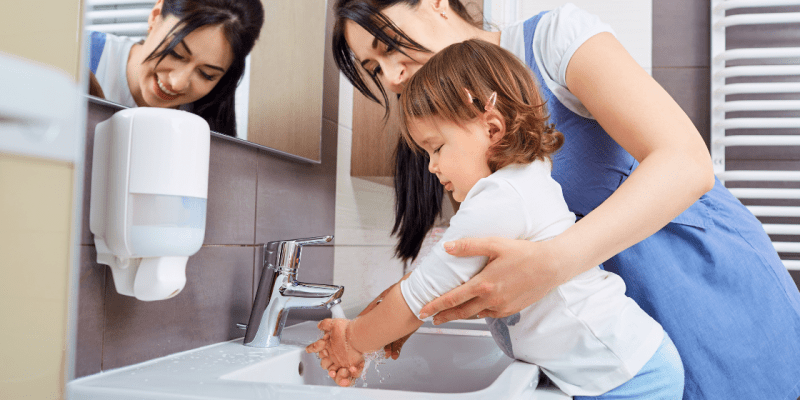You wash your hand after you use the restroom, or handling raw meat, or riding the subway. That’s a great start. However, our  immediate surroundings harbor more bacteria than we like to imagine – and not just the usual suspects. The fact is, germs are all around us – it’s their world, we’re just living in it. Often they’re harmless, but not always, and it’s a good idea to avoid taking any unnecessary risks.
immediate surroundings harbor more bacteria than we like to imagine – and not just the usual suspects. The fact is, germs are all around us – it’s their world, we’re just living in it. Often they’re harmless, but not always, and it’s a good idea to avoid taking any unnecessary risks.
It all starts with awareness – knowing which items, areas and surfaces are likely to harbor unwanted bacteria. From there we can take measures to disinfect those spaces and prevent potentially disease-causing germs from invading our bodies. Read on to learn which everyday items tend to be the most infested. The results may be surprising.
Your keyboard
How much time do you spend on your computer? If you work at an office, write in your spare time, work in coding or software development, or just like to browse the Internet on your laptop, you might have your fingers on the keys for hours a day.
According to an infographic from Quill, an office supply company, the average keyboard is riddled with 3,000 microorganisms per square inch. Research from the University of Arizona maintained a typical desktop contained 400 times more bacteria than the average toilet seat. Of those bacteria, not all are harmless: One British microbiologist swabbed 33 keyboards at an office and found four to be potential health hazards. Yet another study from Chicago’s Northwestern Memorial Hospital identified two deadly, drug-resistant bacteria – Vancomycin-resistant Enterococcus faecium (VRE) and Methicillin-resistant Staphylococcus aureus (MRSA) – could live on in keyboards for as long as 24 hours.

Keep an apple on your keyboard? Not the best idea.
In short, keyboards can get nasty. What makes matters worse is that many people don’t even think to clean theirs on a regular basis. But that’s an essential step to prevent yourself from contracting an infection or illness. Unplug your keyboard, dust it or vacuum it, brush and disinfect, and don’t forget to wash your hands after.
Your smartphone or tablet
If you don’t use your keyboard all that often, there’s still a good chance you’re on your smartphone periodically throughout the day. You browse on it, text on it and talk on it. But the next time you use your smartphone or tablet, think about this: When was the last time you cleaned it? If you’re like most people, the answer may well be “Never.”
Both smartphones and tablets act as hotbeds for bacteria because we use them all the time, bring them with us wherever we go – even the bathroom – and neglect cleaning their surfaces properly. Which?, a product testing and comparison company, conducted swab tests on 30 smartphones and tablets and found one iPad to contain 600 units of Staphylococcus aureus, a bacteria that can cause food poisoning, according to Telegraph.
“A count of 600 on a plastic device of any sort is incredibly high. It indicates that some people don’t wash their hands a lot,” explained microbiologist James Francis, who carried out the research. “In the food industry, if we found those levels of bacteria from a hand swab of a food handler, they’d have to be taken out of the workplace and retrained in basic hygiene.”
“We may wash the dishes, but we don’t wash the faucet.”
Your kitchen sink
…and the sponge, and the towel, according to a BuzzFeed conversation with Kelly Reynolds, Ph.D., director of the Environment, Exposure Science and Risk Assessment Center at the University of Arizona’s College of Public Health. It seems counter intuitive – that’s an area specifically designated for cleaning dirty dishes, so how can it be dirty itself? We may wash the dishes, but we don’t wash the faucet, handle, sponge or towels with the same diligence.
“Your sponge, dishcloth, or common brush you use to wash your dishes … those environments are perfect sites for germs to grow,” Reynolds told BuzzFeed. “Studies at the [University of Arizona] found 60 percent of home dishcloths tested positive for influenza (around eight samples collected); 32 percent for MRSA (38 samples collected); 10 percent for Salmonella; [and] 32 percent for E. coli.”
In 2008, research published in the Journal of Applied Microbiology also found the average kitchen sink held about 100,000 bacteria per square centimeter. So when you wash your hands in the sink and then turn off the faucet with your bare hands, you might have just undone your efforts to be hygienic.
Fortunately, disinfection techniques continue to improve. The best of these products don’t chlorine bleach or other harsh chemicals. Learn more about how SteraMist™ BIT™ provides effective broad-spectrum surface disinfection by killing pathogenic bacteria*.
*see EPA registration (EPA Reg. No. 90150-2)

